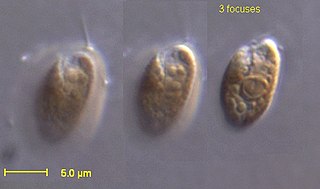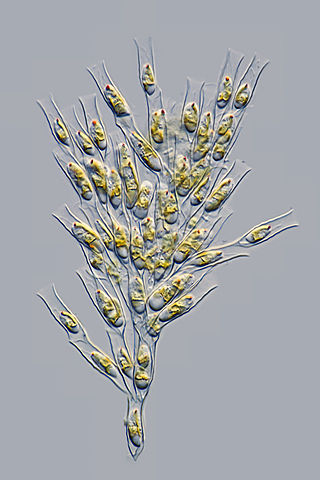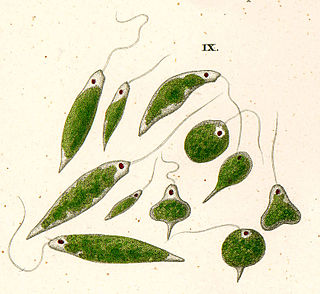
Christian Gottfried Ehrenberg was a German naturalist, zoologist, botanist, comparative anatomist, geologist, and microscopist. He is considered to be one of the most famous and productive scientists of his time.
Cryptomonas is the name-giving genus of the Cryptomonads established by German biologist Christian Gottfried Ehrenberg in 1831. The algae are common in freshwater habitats and brackish water worldwide and often form blooms in greater depths of lakes. The cells are usually brownish or greenish in color and are characteristic of having a slit-like furrow at the anterior. They are not known to produce any toxins. They are used to feed small zooplankton, which is the food source for small fish in fish farms. Many species of Cryptomonas can only be identified by DNA sequencing. Cryptomonas can be found in several marine ecosystems in Australia and South Korea.

Johann Christoph Friedrich Klug, was a German entomologist. He described the butterflies and some other insects of Upper Egypt and Arabia in Christian Gottfried Ehrenberg and Wilhelm Friedrich Hemprich's Symbolæ Physicæ. He was professor of medicine and entomology in the University of Berlin where he curated the insect collections from 1810 to 1856. At the same time he directed the Botanic Garden in Berlin which contains his collections. Klug worked mainly on Hymenoptera and Coleoptera. The plant genus Klugia was named in his honour as well as the butterflies Geitoneura klugii and Heliophisma klugii.

The cryptophyceae are a class of algae, most of which have plastids. About 230 species are known, and they are common in freshwater, and also occur in marine and brackish habitats. Each cell is around 10–50 μm in size and flattened in shape, with an anterior groove or pocket. At the edge of the pocket there are typically two slightly unequal flagella.

Bodo is a genus of microscopic kinetoplastids, flagellate excavates first described in 1831 by Christian Gottfried Ehrenberg. The genus is small, as it has recently been redefined to include only four species. Bodo includes free-living, phagotrophic organisms that can be found in many marine and freshwater environments as well as some terrestrial environments. Being phagotrophic, Bodo feeds on bacteria and other microorganisms that it finds while swimming through its water-based habitats. The swimming-like movement is facilitated by the two unequal flagella that Bodo possesses which arise from an anteriorly located flagellar pocket. Bodo is roughly bean-shaped and is often missed in samples from water or terrestrial environments due to its small size.
Craticula is a genus of diatom that lies on or in the top layers of sediments in the freshwater to brackish water environments it inhabits. In addition to frustule morphology the genus differs from closely related species by its sexual reproduction and movement in response to light.

Peridinium is a genus of motile, marine and freshwater dinoflagellates. Their morphology is considered typical of the armoured dinoflagellates, and their form is commonly used in diagrams of a dinoflagellate's structure. Peridinium can range from 30 to 70 μm in diameter, and has very thick thecal plates.

Dinobryon is a type of microscopic algae. It is one of the 22 genera in the family Dinobryaceae. Dinobryon are mixotrophs, capable of obtaining energy and carbon through photosynthesis and phagotrophy of bacteria. The genus comprises at least 37 described species. The best-known species are D. cylindricum and D. divergens, which come to the attention of humans annually due to transient blooms in the photic zone of temperate lakes and ponds. Such blooms may produce volatile organic compounds (VOCs) that produce odors and affect water quality.

Euglena viridis is a freshwater, single cell, mixotroph microalgae bearing a secondary chloroplast. Their chloroplast is bounded by three layers of membrane without a nucleomorph. Normally, it is 40–65 μm long, slightly bigger than other well-known Euglena species: Euglena gracilis.
Climacosphenia is a genus of marine pennate diatoms in the order Climacospheniales.

Eunotia is a genus of diatoms. They are fresh water diatoms, specifically common in lakes, and they are also common in fossil records, although their siliceous wall design may have been lost and they appear plane, an example is Eunotia tetradon.
Navicula cari is a species of algae in the genus Navicula. Navicula cari occur in eutrophic waters.
Amphiprora is a genus of diatoms belonging to the family Amphipleuraceae.

Gomphosphaeria is a genus of cyanobacteria belonging to the family Gomphosphaeriaceae.
Grammatophora is a genus of Chromista belonging to the family Grammatophoraceae.
Ulnaria ulna is a species of diatom belonging to the family Ulnariaceae.
Hantzschia amphioxys is a species of diatom belonging to the family Bacillariaceae.
Actiniscus is a genus of dinoflagellate belonging to the family Actiniscaceae.
Actiniscus pentasterias is a species of dinoflagellate belonging to the family Actiniscaceae.
Anomoeoneis is a genus of diatoms belonging to the family Anomoeoneidaceae.








